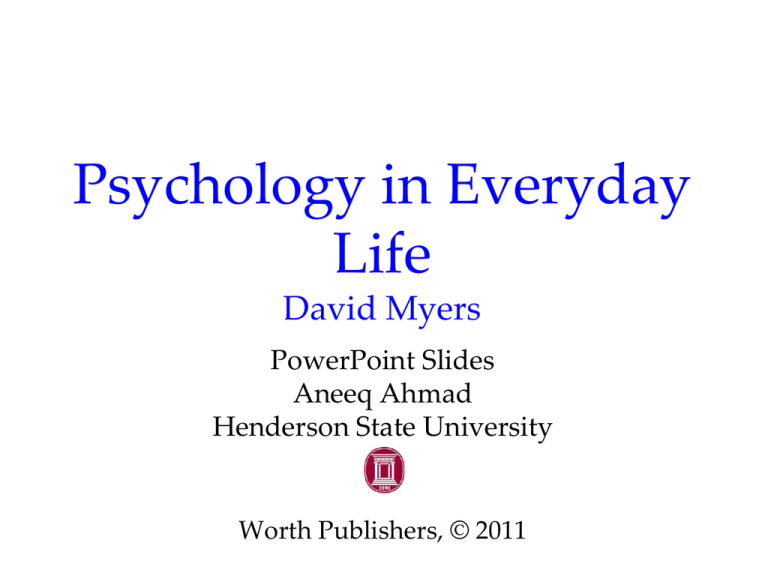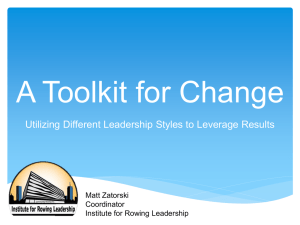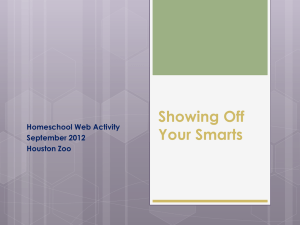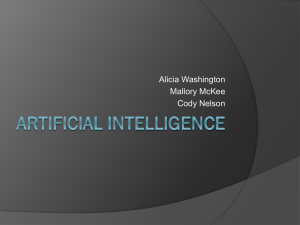Intelligence
advertisement

Psychology in Everyday Life David Myers PowerPoint Slides Aneeq Ahmad Henderson State University Worth Publishers, © 2011 Thinking, Language, and Intelligence Chapter 8 Thinking, Language, & Intelligence Thinking Solving Problems Making Good (and Bad) Decisions and Judgments The Perils and Powers of Intuition Thinking, Language, & Intelligence Language Language Development Thinking Without Language Animal Thinking and Language Thinking, Language, & Intelligence Intelligence What Is Intelligence? One General Intelligence or Multiple Intelligences? Assessing Intelligence The Nature and Nurture of Intelligence Group Differences in Intelligence Test Scores Thinking The study of cognition focuses on the mental activities associated with thinking, knowing, remembering, and communicating. Method of Solving Problems • Trial and Error • Algorithms – step-by-step procedures that guarantee reaching a solution • Heuristics – rules of thumb, simple strategies. Speedier but more error-prone than algorithms • Insight – a sudden realization of a problem’s solution. An aha! moment Insight and the Brain • Study: which word will form a compoud word with: pine, crab, sauce? • Measureed brain activity with fMRI and EEG • Aha! moment preceded by frontal lobe activity (focusing attention) and then burst of activity in right temporal lobe Quick-Thinking Heuristics • Heuristics are useful for making quick decisions • Sometimes, they can get us into trouble • Kahneman and Tversky, among others, have identified many heuristics that people use, and the associated pitfalls The Availability Heuristic • We may base our judgements on how quickly and easily an event comes to mind • Often right, but not always • Does the letter k appear more often as the first or third letter of a word? – Most people say the first, but words like know, kingdom, king are outnumbered 5 to 1 by words like make, like, asked, etc. Fixation • Some heuristics can lead to fixation, the inability to see a problem from a fresh perspective How can you arrange six matches to form four equilateral triangles? Fixation People often become fixated on twodimensional solutions Confirmation Bias • We tend to search for information that supports our preconceptions and ignore, distort, or forget to seek evidence against our ideas • Wason (1960): Guess the rule for the following sequence. You may give your own sets and see if they work with the rule: 2-4-6 • They were seldom right but never in doubt. (The rule: each subsequent number must be larger) Overconfidence • Overconfidence: we overestimate the accuracy of our beliefs and decisions – Example: we tend to overestimate our future free time • It’s adaptive: self-confident people are happier, make tough decisions more easily, and seem more believable to others Framing • Framing, the way an issue is posed, can significantly affect decisions and judgments • “Are these condoms effective if they…” – “…have a 95% success rate?” 9 in 10 said yes. – “…have a 5% failure rate?” 4 in 10 said yes. • Organ donors – “Opt out” countries – nearly 100% donors – “Opt in” countries (including U.S.) – only 25% donors Those who understand the power of framing can use it to influence our decisions Our Beliefs Live On • Belief perseverance – we cling to beliefs and ignore evidence that proves they are wrong • One way to combat this is to consider the opposite – imagine if the evidence had the opposite results, what would you think? • Study: Students would not let facts change their belief –The death penalty is/is not an effective deterrent. The Perils and Powers of Intuition • Intuition is used often. Much of our thinking occurs “offscreen” • Intuition is adaptive. Fast and frugal heuristics allow us to react quickly and often reliably • Intuition is recognition born of experience, or “analysis frozen into habit” • Intuition can sometimes be perilous, guiding us in the wrong direction. Especially when we overfeel and underthink. We must check our intuitions against reality Language • Language consists of our spoken, written, or signed words and the ways we combine them to communicate meaning • The evolution of language was a huge leap forward for our species. We can communicate information from one individual to the next, and from one generation to the next. Language Development • About 50% of our speech consists of only 150 words, but by high school we know about 60,000 words! • How did we learn these words? • How do learn our language’s syntax (the correct way to form words into sentences)? When Do We Learn Language • Infants start without language • At 4 months, can recognize speech sounds and enter babbling stage, uttering various sounds (ah-goo) – Around 10 months, babbling sounds more like parents’ language • Around 1 year, enter one-word stage, speaks primarily in single words (“Doggy!”) • By age 2, enter two-word stage, which involves so-called telegraphic speech (“Want juice!”) How Do We Learn Grammar? • Chomsky: All languages share a universal grammar – e.g., nouns, verbs, adjectives • Humans are built with a built-in readiness to learn language • Childhood is a critical period for learning language – must be exposed by age 7 New Language Learning Gets Harder With Age Grammar test given to Asian immigrants ten years after arriving in the U.S. Thinking Without Language • We often think in images • Mental practice can be valuable for musicians, athletes, and others • Once you have learned a skill, watching others perform it or imagining it can trigger activity in the same brain areas The Power of Imagination • Imagining the experience of pain activates some of the same brain regions as the actual experience Animal Thinking and Language • Animals are smarter than you may realize • Forming concepts – Shown a picture of a new chair, pigeons can peck a key that means “chair” – Great apes (e.g., chimps, gorillas) can form concepts like “cat” and “dog”. – Clusters of frontal lobe neurons will then fire to new “cat-like” objects, for instance Animal Thinking and Language • Numerical ability – Irene Pepperberg trained Alex, a grey parrot, who could name and categorize objects, and count up to six. – Alex could add clusters of objects, and respond to questions like “What color four?” with the correct color of the objects in a group of four. Animal Thinking and Language • Displaying Insight – Köhler (1925) placed a piece of fruit and a long stick outside the cage of Sultan the chimpanzee, outside his reach – Inside the cage was a short stick. – After several failed attempts, Sultan paused and then used the short stick to reach the long stick, and in turn the fruit! Animal Thinking and Language • Tool use – Forest chimpanzee use many different tools • a heavy stick for making tools • Light, flexible stick for termite fishing – Researchers have found over 39 local customs related to chimpanzee tool use, grooming, and courtship. • One group may slurp termites right off the stick, others may pluck off individually Mother chimp teaches her young to use a stone hammer Animal Thinking and Language • Cultural Transmission – Group differences in chimpanzee customs are not genetic, but cultural. – Chimpanzees invent behaviors and transmit them culturally to peers and offsprings, as do orangutans and dolphins – Some dolphins have learned to use sea sponges to protect their nose while probing the sea floor for fish Animal Thinking and Language • Animals have many other cognitive skills – A baboon knows the voice of each individual in its 80-member troop – Sheep can recognize and remember individual faces – Chimps and some monkeys can read a human’s intent from her facial expression – Great apes, dolphins, and elephants can recognize themselves in a mirror – Chimpanzees have shown altruism, cooperation, and group aggression Do Animals Have Language? • Animals show impressive comprehension and communication – Vervet monkeys have different alarm calls for different predators – eagle, leopard, snake. – Rico the border collie has a 200word vocabulary. • But is it language? Do Animals Have Language? • In the 1960s, Gardner and Gardner taught Washoe the chimpanzee sign language – She could use up to 181 signs – Sentences were very simple – “You me go out, please.” – Creative combinations – “water bird” for a swan – Another Chimp, Louis, learned the signs directly from Washoe Criticisms of Chimpanzee Language • Vocabulary and sentences are simple, like that of a 2-year-old human – Apes gain their limited vocabulary only with great difficulty • Chimps can make signs or push signals for a reward. Is this just conditioning? • Perceptual set – are we just seeing what we want to see? • Chimps lack human syntax The Case for Chimpanzee Language • Kanzi, a bonobo, could understand syntax in spoken language • Like humans, early life in chimps may be the critical period for language • If language means verbal or signed expression of complex grammar, only humans have language • If we mean only the ability to communicate through a meaningful sequence of symbols, then apes are also capable of language What Is Intelligence? • Intelligence is the ability to learn from experience, solve problems, and use knowledge to adapt to new situations • The definition can vary depending on context or culture General Intelligence • Charles Spearman (1863-1945) believed we have one general intelligence (g) at the heart of all intelligent behavior • Individuals who do well in one area tend to do well in other areas Savants • General intelligence doesn’t explain those with savant syndrome, in which a person with otherwise limited mental ability has an exceptional specific skill • Savant artist Stephen Wiltshire drew the Tokyo skyline from memory after a 30-minute helicopter ride and a visit to the top of a skyscraper Multiple Intelligences • Howard Gardner has identified 8 relatively independent intelligences • However, factor analysis research has confirmed that there is a general intelligence factor, g Creativity • Creativity is the ability to produce new and valuable ideas • Requires a certain level of intelligence, but is not the same thing • Exceptionally creative architects, scientists, and engineers are usually no more intelligent than those of their less creative peers What is Creativity? • Five necessary parts (Sternberg, 1988, 2003) 1. 2. 3. 4. 5. Expertise Imaginative thinking skills A venturesome personality Intrinsic motivation A creative environment Emotional Intelligence • Emotional intelligence is the ability to perceive, understand, manage, and use emotions. – Part of social intelligence • Emotionally intelligent people tend to avoid being overcome by emotion, perform better on the job, and can delay gratification for longrange rewards – Often succeed in domains where academically smarter but emotionally less intelligent people fail Assessing Intelligence • Intelligence can be considered defined as measured by intelligence tests • Psychologists started measuring intelligence in the early 20th century – Some measured aptitude – the ability to learn – Some measured achievement – what people have already learned Alfred Binet • Developed early intelligence tests based on new laws requiring all children to attend school • Assumed all children follow the same intellectual development path, but at different rates • Coined the idea of mental age, the chronological age that most typically corresponds to a given level of performance Measuring IQ • Lewis Terman, a professor at Stanford, revised the Stanford-Binet test • This test reported a person’s intelligence quotient: mental age IQ chronological age 100 • Today, intelligence tests represent performance relative to average performance of others the same age Separate Scores for Separate Skills The Wechsler Adult Intelligence Scale (WAIS) is the most widely used intelligence test – Contains verbal and performance (nonverbal) subtests Tests of a “Good” Test • Was the test standardized? • Is the test reliable? • Is the test valid? Standardization • Standardization defines scores by comparing them with a pretested group (representative sample of people) • Graphs of test-taker’s scores typically form the normal curve Reliability and Validity • Reliability is the extent to which a test yields consistent results • Validity is the extent to which a test measures or predicts what it is supposed to • A two-foot “yardstick” would be reliable, but not valid Intelligence: Nature and Nurture • Intelligence runs in families – but why? Twin Studies • Genes matter: Identical twins highly correlated • Environment matters: fraternal twins, compared to non-twin siblings, are more alike in intelligence but not in genes Adoption Studies: Surprising? • Mental similarities between adopted children and their adopted families decrease with age • Similarities with biological parents increase as children gain life experience • Does this support the nature or nurture view of intelligence? Heritability • Heritability is the portion of variation among individuals attributable to genes – The heritability of a trait can vary depending on the population and the environment • Intelligence is usually about 50% heritable – Means that heredity is responsible for 50% of the variation in intelligence studied • Our genes shape the experiences that shape us – Taller children picked for basketball, get more practice, more coaching, and be better at basketball later Environment and Intelligence • Malnutrition, sensory deprivation and social isolation early in life can permanently impact intelligence • Infants need care that responds to their own inputs, so they develop a sense of personal control over their environment • However, there is no recipe for turning babies into geniuses Ethnic Differences Two disturbing but agreed-upon facts: • Racial groups differ in their average intelligence score • High-scoring people (and groups) are more likely to have high levels of education and income • E.g., average score for blacks is ten points less than for whites • But the normal curves overlap: group differences provide little basis for judging individuals Might the Racial Gap Be Environmental? • Even if variation between groups correlates with genetic differences, the average difference between groups may be wholly due to the environment, e.g. education, poverty Might the Racial Gap Be Environmental? • Under the skin, races are highly alike – Average genetic difference between two Icelanders or two Kenyans is greater than group difference between Icelanders and Kenyans • Race is not a neatly defined biological character • There are generation-to-generation differences with the same population – Today’s you are better-fed, better-educated, and more test-prepared than those of previous generations • Infants score equally well on intelligence measures regardless of race • Schools and culture matter Gender Differences • In terms of the ways we think, feel, and act, gender similarities vastly outnumber differences. • No differences in general intelligence, g • Still, there are some differences in ability level between men and women Gender Differences • Verbal memory. Females excel at verbal fluency, are better spellers, and have better memory for facts. • Nonverbal memory. Females are better at locating objects, and at associations with pictures and sensory information. • Emotion-detecting. Females are better at detecting emotion and intent from expression • Math aptitude. Males tend to be better, but only in cultures that associate being male with science and math. Gender Differences • Spatial abilities. Most reliable male edge. Males do better at mental rotation. Thought to be evolutionarily related to tracking prey and returning home. Also may be due to experience with play using spatial abilities. • Greater male variability. Males’ scores vary more than females – they outnumber females at both the low and high extremes. Are Test Questions Biased • May be biased by a person’s culture experience • In terms of prediction, they are not biased – predictive validity is the same for all groups Stereotype Threat • Some may feel that their performance will support others’ stereotypes of their group – this is stereotype threat. – Women underperformed on a math test except when they were told that women usually do as well as men on the test • Danger: telling people they need help might hurt their performance • Countering this effect: Self-affirmation can improve performance The Bigger Picture • Intelligence scores do not portray a whole person; for example, they do not describe the skills and dedication of someone devoted to helping others.








